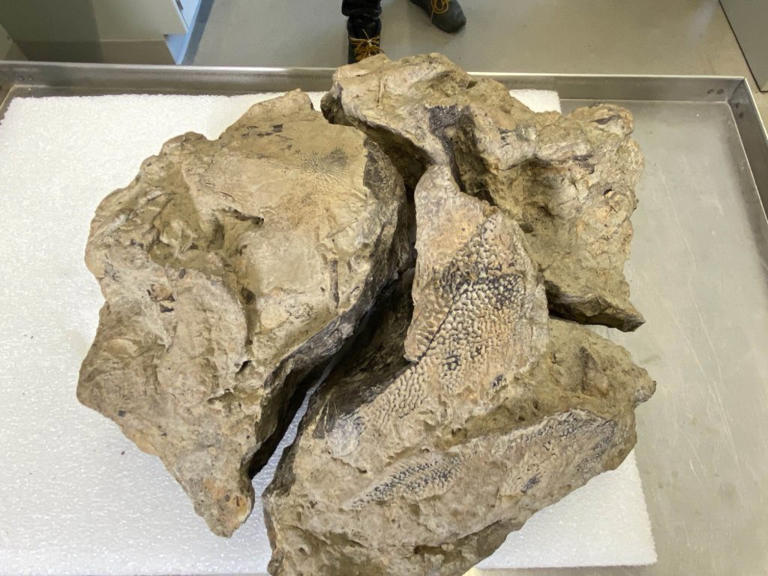Story by Caley Gibson • 22h

A fragment of a 72-million-year-old sturgeon was discovered in Edmonton's River Valley in February 2023.© Global News
A fragment of a 72-million-year-old sturgeon has been unearthed in Edmonton’s River Valley.
The discovery was made by hikers in Capilano Park in February 2023.
What they thought might be a fragment of dinosaur skin turned out to be a skull belonging to an ancient sturgeon.
Researchers at the University of Alberta believe the fish would have been two metres long when it was alive.
This is the first new species of fossil fish discovered within Edmonton, according to researchers, who have named the species Boreiosturion labyrinthicus. The name references the labyrinth or maze-like patterns on the skull.
Luke Nelson, co-author of a study recently published about the find, said the most interesting thing about the new sturgeon fossil is the distinct patterns on the back of its skull.
“There are three unique patterns, different from anything previously described from the time period,” Nelson said. “This is from a part of the Cretaceous Period from which we didn’t have any North American sturgeon before."
Sturgeons are found in North American freshwater environments and still exist and live in the North Saskatchewan River as a protected species.
The freshwater Horseshoe Canyon Formation, where Capilano Park now lies, took shape roughly 72.2 to 73 million years ago during the Cretaceous Period.
U of A researchers say this fossil fills a gap in what is known about the distribution of sturgeons during the end of the Cretaceous Period, before the mass extinction event that wiped out dinosaurs.
The discovery also fills a geographical gap between the fish being found in southern Alberta, Montana and North Dakota, and Alaska and Peace River farther north.
“One really cool thing about this fossil is that it represents an ancestor of something that we have still alive today," Nelson explained. "We still have sturgeons in Edmonton. We have lake sturgeons, which are pretty large species of sturgeons around two metres in length.
“It’s very cool to learn more about the evolutionary history of the species that we still have around today.”
Nelson urged anyone who comes upon something they believe may be a fossil of any kind to contact the U or A or the Royal Tyrrell Museum.
"It could be of very big importance to paleontology as a field," he said. “Our goal as paleontologists is to kind of piece together a larger picture of how the world was back in time.
“With this, we can gain more knowledge about the ecosystem in general. If this was just sitting in someone’s house, that would just not be doing the same amount of purpose. So I think it is really important if you find something you think is cool, call it in.”
Nelson also stressed the importance of preserving the current sturgeon in the North Saskatchewan River.
“They’re some of the largest bony fish we have today and have been around since dinosaurs were walking around on land,” he said. “They almost look like dinosaurs, because they’ve got these massive sizes and enormous scales running down their back that make them look kind of wicked.”
The sturgeon skull is now being housed in the U of A’s laboratory for vertebrate paleontology.
No comments:
Post a Comment